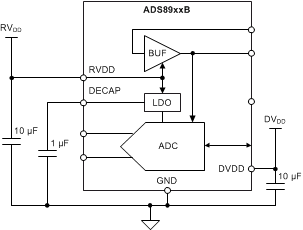JAJSCA2B June 2016 – January 2018 ADS8910B , ADS8912B , ADS8914B
PRODUCTION DATA.
- 1 特長
- 2 アプリケーション
- 3 概要
- 4 改訂履歴
- 5 Pin Configuration and Functions
- 6 Specifications
-
7 Detailed Description
- 7.1 Overview
- 7.2 Functional Block Diagram
- 7.3 Feature Description
- 7.4 Device Functional Modes
- 7.5
Programming
- 7.5.1 Output Data Word
- 7.5.2 Data Transfer Frame
- 7.5.3 Interleaving Conversion Cycles and Data Transfer Frames
- 7.5.4 Data Transfer Protocols
- 7.5.5 Device Setup
- 7.6
Register Maps
- 7.6.1
Device Configuration and Register Maps
- 7.6.1.1 PD_CNTL Register (address = 04h) [reset = 00h]
- 7.6.1.2 SDI_CNTL Register (address = 008h) [reset = 00h]
- 7.6.1.3 SDO_CNTL Register (address = 0Ch) [reset = 00h]
- 7.6.1.4 DATA_CNTL Register (address = 010h) [reset = 00h]
- 7.6.1.5 PATN_LSB Register (address = 014h) [reset = 00h]
- 7.6.1.6 PATN_MID Register (address = 015h) [reset = 00h]
- 7.6.1.7 PATN_MSB Register (address = 016h) [reset = 00h]
- 7.6.1.8 OFST_CAL Register (address = 020h) [reset = 00h]
- 7.6.1.9 REF_MRG Register (address = 030h) [reset = 00h]
- 7.6.1
Device Configuration and Register Maps
-
8 Application and Implementation
- 8.1 Application Information
- 8.2 Typical Application
- 9 Power-Supply Recommendations
- 10Layout
- 11デバイスおよびドキュメントのサポート
- 12メカニカル、パッケージ、および注文情報
パッケージ・オプション
メカニカル・データ(パッケージ|ピン)
- RGE|24
サーマルパッド・メカニカル・データ
- RGE|24
発注情報
9 Power-Supply Recommendations
The devices have two separate power supplies: RVDD and DVDD. The internal reference buffer and the internal LDO operate on RVDD. The ADC core operates on the LDO output (available on the DECAP pins). DVDD is used for the interface circuits. RVDD and DVDD can be independently set to any value within their permissible ranges. During normal operation, if RVDD supply drops below the RVDD minimum specification, ramp the RVDD supply down to ≤ 0.7 V before power-up. During power-up, RVDD must rise monotonically to the recommended minimum operating voltage.
The RVDD supply voltage value defines the permissible range for the external reference voltage VREF on REFIN pin as:
Place a 10-µF decoupling capacitor between the RVDD and GND pins, and between the DVDD and GND pins, as shown in Figure 118. Use a minimum 1-µF decoupling capacitor between the DECAP pins and the GND pin.
 Figure 118. Power-Supply Decoupling
Figure 118. Power-Supply Decoupling